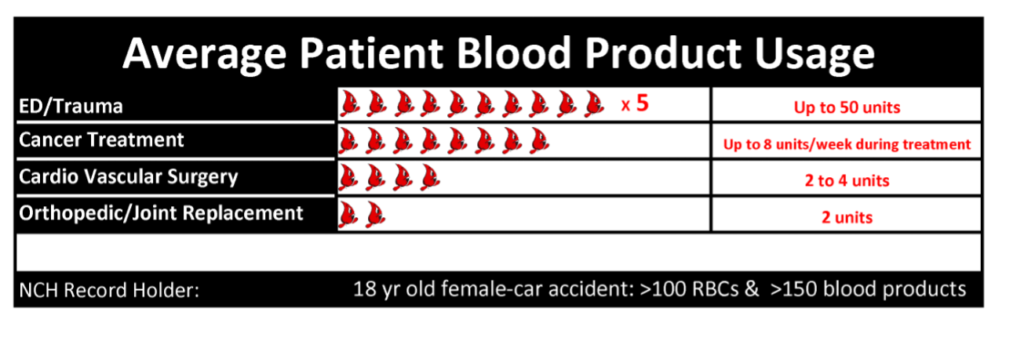About Blood
Community Blood Center / About Blood
About Blood
Blood is a lifesaving resource and there is no substitute for it. Scientists have tried to develop a synthetic alternative to blood but have thus far been unsuccessful in duplicating the life-sustaining properties that blood has. It can only come from volunteer donors. Each pint of donated blood can be broken down into components: red cells, plasma, and platelets to save up to three lives. Women have about ten pints and men have about 12 pints of blood in their bodies.
- Red Cells are responsible for carrying oxygen throughout the body and removing the carbon dioxide. Cancer, trauma and surgical patients as well as people who have blood disorders such as anemia, hemophilia require frequent transfusions.
- Platelets are tiny blood cells that act as clotting agents to help control bleeding. They make a huge difference to critically ill patients. They are vital in helping people to recover from leukemia, open-heart and transplant surgeries and for people who have blood disorders. Cancer patients often need platelet transfusions after receiving chemotherapy and radiation therapy which often destroy healthy cells.
- Plasma is the liquid portion of the blood that acts as a transport system to carry all the blood cells, salts, sugars, proteins and nutrients throughout the body. Patients with severe infections, liver failure and serious burns are often transfused with plasma.

Blood Types
A+, A-, B+, B-, O+, O-
In an emergency, anyone can receive type O negative red blood cells. Therefore, people with type O negative blood are known as “universal donors.” In addition, individuals of all types can receive type AB plasma.
Blood Compatibility Chart
| Blood Type | Blood Type You Can Receive |
|---|---|
| O | O- |
| O+ | O+, O- |
| A- | A-, O- |
| A+ | A+, A-, O+, O- |
| B- | B-, O- |
| B+ | B+, B-, O+, O- |
| AB- | AB-, A-, B-, O- |
| AB+ | Any blood type |
Percentage of US - Blood Type Chart
The approximate distribution of blood types in the U.S. blood donor population is as follows. Distribution may be different for specific racial and ethnic groups and in different parts of the country.

- 239-624-4120
- Monday, Thursday and Friday
8:00 a.m.-4:00 p.m.
Tuesday
11:00 a.m.-7:00 p.m. - Map and Directions
Quick Links
Frequent Donor Contests
- Page 1 >
- Page 2 >
- Page 3 >
- Page 4 >




